Does Wireless Mic NPRM Set a Record for Number of Questions?
Let me count the ways:
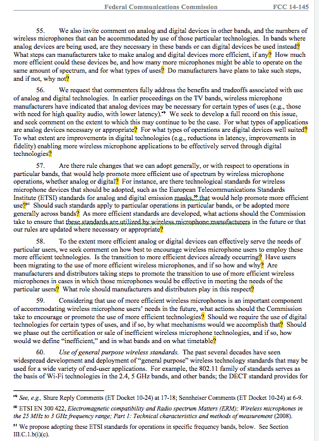
Above is a typical page with all the questions ending in question marks highlighted. There are 314 such questions and they appear on 49 different pages! Is that all? Of course not! The multiple authors of this document are very creative in making and hiding questions to make an exact count difficult. The word "seek" appears 158 times in such uses as
- "Further, we seek comment on proposals for authorizing wireless microphone operations in additional spectrum bands, consistent with the Commission’s overall spectrum management goals_ - para. 4
- "In addition, we seek comment on authorizing licensed wireless microphone operations in other bands. " - para. 30
- "We seek on comment on the different groups of wireless microphone operators and their various uses of microphones, including the particular applications served by the microphones, the types and number of devices used, the extent to which the devices are analog or digital, the settings in which they are used, and the frequency bands they use. " - para. 33
- "We also seek comment on the nature of the demand for wireless microphones by various wireless microphone users" - para. 38
Arguably some of the uses of "seek" in the text are not actually questions, so the count of 158 is a little high. But FCC staff has ways of asking questions without either the use of a question mark or the work "seek":
- "We ask that the different user groups, or the manufacturers of products for these groups, provide detailed information about the particular nature of wireless microphone uses by different groups of users." - para. 33
Your blogger actually compiled and submitted a list of all the 176 questions in Docket 14-177 (24+GHz 5G), but he does not have the patience to do the same in this tangled mess. As we have indicated in the posts mentioned earlier, both UK's Ofcom and Industry Canada number questions in their NOI and NPRM counterparts. Now some would say that they are not subject to the APA like FCC is, but having attended the FCBA reception at the Supreme Court last night, let me boldly say that I don't think the Supreme Court would remand an FCC decision just because its questions had numbers. It might remand a decision because it did not address the record and with so many tangled questions, how does one address the record?
The "Duplexer Gap" Issue Has Nothing to do With the Future of Local TV News!
National Association of Broadcasters, Radio & Television Digital News Association, Microsoft Corporation, Utilities Telecom Council, Wireless Internet Service Providers Association (WISPA), Engine Advocacy, Spectrum Bridge, Consumers Union, Consumer Federation of America, Open Technology Institute at New America, Public Knowledge, Free Press, Common Cause, Benton Foundation, Rural Broadband Policy Group, Institute for Local Self-Reliance, Access Humboldt, and Akaku Maui Community Media.
Kudos to those who were able to bring such a coalition together on any issue! We do not necessarily disagree with the bottom line of the letter with respect to preserving the duplex gap for unlicensed and wireless mic use, but we want to make clear:
Future of Local TV News Does Not Depend on Duplex Gap Spectrum!
The letter has several statements on this issue:
- “Placing television stations in the duplex gap …would significantly undercut the public interest benefits associated with the auction ..r by preventing both mobile news reporting and deployment of low-band unlicensed spectrum in the places where low-band spectrum is most needed to effectively provide these services.” p. 1
- “…eliminating reserved spectrum for wireless microphones could leave newsgathering operations without necessary spectrum to cover breaking news.” p. 1
- “…preserving critical news reporting” - p. 2
- “The proposal would hamper reporting of breaking news in the most populous cities.” - p. 2
The above statements only make sense with respect to using the wireless microphones that are presently owned by TV stations. TV stations sell for prices in the order of millions of dollars. The value of their wireless mic equipment inventory is a negligible fraction of their net worth. While it is true that alternative spectrum wireless mics are not available in the US today, the main reason is the basic truism:
Free spectrum is always cheaper than any new technology!
And the wireless mic spectrum referred to in the letter is FREE spectrum using outdated technology!
Today’s Wireless Mic Spectrum is Both a Technological and Policy Anachronism
Maj. Armstrong - Inventor of FM
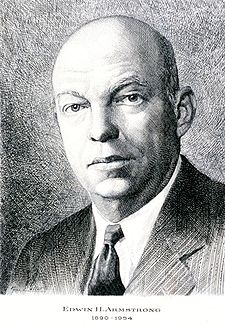
The irony is that even with the duplex gap available, in major cities theatrical productions, concerts and major sporting events will be hard put to use traditional wireless mic technology because of the near or complete elimination of virtual channels.
Since 1995 commercial spectrum users, e.g. broadcasters, have generally been expected to pay for spectrum use. Note that the PTC-related rail accident in Philadelphia highlighted the fact that Congress ordered he railroad industry to implement spectrum-based PTC but told them to buy spectrum access for existing licensees. Why do broadcasters feel they are entitled permanently to free spectrum access for wireless mics?
Is there a technological option? Yes at least one and certainly many others. But FCC's focus at throwing more spectrum at the problem removes any incentive for private capital formation for more efficient technology. Qualcomm developed several years ago a technology called FlashLinq for peer-to-peer communications in cellular spectrum under the control of cellular carriers similar tpthat way they control femtocells. This technology would allow cellular carriers to sell access to inevitable "white space" in their service areas that can only be used for lower power short range communications. Why is the product dead or dormant? Neither wireless mic users nor cellular carriers want anything to do with it! Wireless mic users are addicted to free spectrum and obsolescent technologies. Cellular carriers are addicted to the "killer app" mentality where they don't want a new service or revenue stream unless it is huge. Cellular operators can't fathom that eliminating other spectrum using by converting them to customers rather than fellow spectrum lustors might actually help their long range goals.
Today's smartphones are basically 2 way communications systems capable of sending and receiving 100s of kilobits or more of data. While your standard iPhone offers neither broadcast quality audio not easy access for sending high speed data from an external source, it is not rocket science to modify the interface to permits external high quality microphones with analog/digital convertors to interface with such a smartphone so the on the screen newsperson gets his/her audio out that way, not via Part 74 spectrum.
Other technical option are possible, but who would develop them given the present wireless mic policy impasse at FCC?
The issue of spectrum for concerts and theater is more complex technically because of both high quality audio requirements and requirements for minimum delay (less than 10 ms.). But again this does not seem impossible if FCC stops throwing spectrum at users with outdated technology who don't want to pay for spectrum.
So there may be reasons for keeping the "duplex gap", but the future of local news isn't one of them.
New Technologies for Wi-Fi
The unlicensed crowed has not been sitting on its hands while all this new technology has been developed on the cellular side. IEEE Communications magazine in its November 2014 issue has a focus on the “The Future of Wi-Fi”.
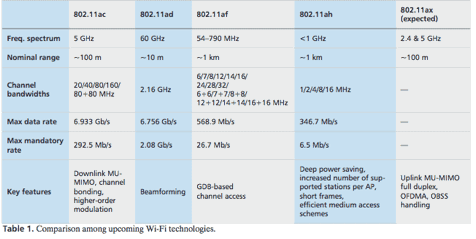
Above is a table from one of the Wi-Fi articles that gives some future versions of Wi-Fi along with their expected technical features.
These 4 papers give an overview of the new technologies that are expected to be implemented in licensed and unlicensed wireless communications in the next few years. The wireless mic gang might want to look at these technologies and ask why they are still obsessed with 1930s-based wideband FM. But other spectrum users, including federal users regulated by NTIA, might want to view these as a data point they should be judged by.
Fundamental Flaw of the Docket 14-165/6 4 MHz Wireless Mic Set-Aside:
Giving Free Spectrum for “Licensed Wireless Microphones” to Mostly Rich Corporations That Will Inevitably Be Very Lightly Used

However, certain private entities decided to expand this de jure use with additional de facto use without the benefit of public policy deliberations and such use would appear to have been a criminal violation of §301. Yet the wireless mic industry, their non broadcast customers, and the FCC quietly looked the other way for decades. In Docket 01-75 the FCC described the NPRM as “an extensive review of the BAS rules and propose changes to create a more efficient BAS that can readily adapt to regulatory and technological changes.” The hypocrisy of the wireless mic industry is evident in the filing by Shure, Inc. in Docket 01-75, the only filing by any party interested in non broadcast/non film production use of wireless mics. At the time Shure was routinely marketing wireless mics to noneligible users by implying that they were Part 15 devices that did not need a license. The Shure reply comments state unambiguously in a heading:
![]()
(LPAS = Low Power Auxiliary Stations = Part 74, Subpart H)
The Shure filing goes on to cryptically mention on p. 4
While subtlely acknowledging illegal uses, they never asked that they be normalized and no other wireless mic user or manufacturer spoke at all in the 3 year long proceeding!“numerous activities conducted by businesses, religious and educational institutions, governmental bodies at all levels,law enforcement agencies, musical productions, and theatres (to name but a few). The American public relies heavily upon wireless audio equipment in the course of their daily work, worship, education and entertainment activities.”
In the new twin FCC NPRMs that deal with wireless mics, Dockets 14-165/166 we have the following proposed band plan for the “duplexer gap” between the cellular uplinks and downlinks in the repurposed 600 MHz TV spectrum after the incentive auction.
Note the 4 MHz orange colored block labeled “Licensed wireless microphones”. What is this block? It is restricted to the classic Part 74 eligibles (broadcasters CATV systems, and film producers) plus, as a result of a May 2014 R&O, the “Large venue owners or operators as defined in § 74.801 and Professional sound companies as defined in § 74.801”. The 2 new categories of users both have the requirement of routinely using 50 or more wireless microphones in productions. Note that while these entities have “licenses”, they are paying no apparent fees at all for spectrum access. (Broadcasters both application fees under §1.1104 and pay annual fees under §1.1153, but there do not appear to be any fees at all for wireless mic users in the litany of Part 1, Subpart G fees unlike virtually all commercial users.)
We note that for about 20 years, the general trend has been users of spectrum for commercial purposes pay for spectrum access. So the nonbroadcast wireless mic users are being rewarded for their illegal squatting up until 2010 with guaranteed access to spectrum at no cost at all! Who are these impoverished users? Here are two recent Internet ads from newly eligible users:

Could Lion King and their corporate parents at Disney afford to pay for spectrum use?


But the worst part of the proposal is that it is a return to the “Command & Control” spectrum model of the past that rewards special interests and contributes to the overall low occupancy of US spectrum. When averaged over the entire US and over the entire year, the 4 MHz set aside for “Licensed wireless microphones” will likely be the least utilized nonpublic safety spectrum in the US and may actually be the lowest utilized spectrum even considering public safety. (Public safety spectrum tends to have low utilization due to the bursty unpredictable nature of emergencies and the need to size the spectrum for the worst case incident.)
Yes, in a small section of Manhattan it will be used for a few hours a day. In Central Park and other concert venues it will be used for a few hours a few days of the year. Near some large churches it will be used a few hours a week. But the rest of the time it will be denied to all other users, both licensed and unlicensed. At present wireless mic licensed users have priority access to “vacant” TV channels. The new proposals will make them the sole possible user of 4 MHz, deny that spectrum 24/7 to other users even if there is no wireless mic use within 100 miles, and guarantee the very low utilization of that spectrum 24/7 in 50 states plus territories. Why?
So you ask how would your blogger deal with spectrum for wireless mics? He would have a set aside for wireless mics, but it would be much smaller, it would have a spectrum efficiency standard similar to Part 90, and it would apply to only small wireless mic system users who can not afford the transactions costs of a normal licensed system. Thus eligible users would be wireless mics in office conference rooms, places of worship with modest audio systems, and hotels for DJs and conferences. Perhaps a 10 microphone maximum. For bigger users who need high reliability, they would have to pay for spectrum access either through a variant of the UK system spectrum leasing system managed by Arqiva or through a femtocell-like system provide by cellular operators. For more details on the femtocell-like alternative, see an interview with your blogger in the wireless mic blog RF Venue.
In the UK,all wireless mic users (PMSE in UK jargon) have been paying for spectrum for over a decade. Has it resulted in the “the day the music died”?
This 4 MHz proposal is the worst example of Command & Control spectrum policy since it was discredited in the Spectrum Policy Task Force report in 2002!
UPDATE
For a very different point of view, try this piece from NPR. (Oddly, it also uses Lion King as an example, but doesn’t mention the ticket price. FYI, in London where Disney has to pay for spectrum for wireless mics/PMSE, the cost of seats near the front is £70.75 - £90.00 ($111- $141) so less than in NYC with present “free spectrum”.)
Our recent FCC filing in Docket 14-166 expands on the above discussion.
Olympic News: Wireless Mics Work Well in a Marketplace Environment!
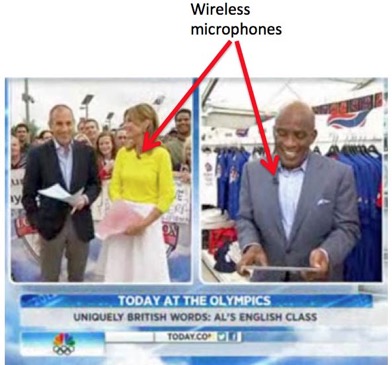
Watching the Olympics, you might not have noticed an interesting spectrum policy point: Wireless microphones (mics) are being used widely without any technical problems in a spectrum policy environment very different from the US: wireless mic users like most other spectrum users in the UK (including military users) are paying for spectrum access!
As we enter the era of incentive auctions, one of the issues people in Washington do not want to talk about is the future of wireless mics and their current spectrum. Clearly wireless mics are a socially constructive and economically important use of spectrum for the entertainment industry, conference facilities, and other applications. But wireless mics developed in the US on the assumption that interstitial use of “vacant” TV channels was a “free good”. Under NTSC analog technology with the UHF taboos resulting from poor TV receiver technology, or at least poor predictions of TV receiver technology, this was mostly true. Of course, the questionable large scale marketing by companies like Shure, Inc. of wireless mics to users not legally eligible to use them only complicated the issue.
Similarly the unwillingness of the entertainment users of wireless mics to confront the legal contradictions of using the technology as a key building block of their shows until Docket 04-186 showed up was also irresponsible, (One wonders about Walt Disney Co. with respect to its dual roles as a TV broadcasters with multiple licenses and the owner of Broadway shows that violated the Communications Act through their illegal use of wireless mics until recently. Had their lawyers done a risk analysis of this issue?)
It does not take much of a crystal ball to see that in the long term wireless mic use of UHF-TV spectrum will become questionable as this spectrum is in greater and greater demand. While mire less mics are important, their use is very sparse in space and time and normal allocation models are not a good match.
In the UK, Ofcom’s “dedicated band manager” for “programme-making and special events”/PMSE is JFMG, which is now owned by Arqiva, the company that actually owns and operates broadcast transmitters in the UK - operated on behalf of the programming originators. JFMG buys spectrum at market prices and then leases it for PMSE uses such as wireless mics to users who pay according to the amount of resources they use.
As we have seen in the Olympics it works! I suppose NBC would have preferred the US system where spectrum access is free. But why is that so important? While marketplace forces do not work all the time for all applications, the UK-style system is probably a better way to handle the wireless mic problem and will ease the inevitable transition to new technologies in various bands. Does anything think FCC really has the patience to handle that well?
FCC Forum on Indoor Deployments of Small Cell Sites

On October 28, 2011 FCC held a Public Forum on Indoor Deployments of Small Cell Sites in the Commission Meeting Room with live video online. The forum was organized by the Wireless Telecommunications Bureau, in conjunction with the FCC's Technical Advisory Committee (TAC) Small Cell working group and Spectrum Task Force. I have been somewhat critical of how little the TAC has been asked to do and how little it has accomplished since its formation, but this was certainly a positive move and the FCC staff and the TAC members certainly deserve credit for bringing public attention to this important issue.
The FCC PN on the event said,
Recent developments in technology offer an increasingly wide array of products to provide wireless coverage and capacity in limited or confined areas. Together, they offer potentially useful solutions to addressing the exploding demand for spectrum that is being driven by the exponential growth in wireless data services. The forum will provide an overview of small cell technologies currently available or soon to come on line, including software defined radios and enhanced Wi-Fi in both licensed and unlicensed spectrum. In addition, panelists will explore the business opportunities and challenges involved in expanding wireless data coverage. Finally, the forum will assess the potential economic impact of small cell deployments, particularly with respect to job creation, and explore possible policy approaches.
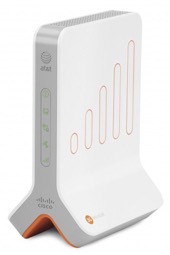
That is what was basically discussed and the forum dealt with both femtocells that act as tiny base stations for cells phones indoors and then connect to the network over the internet - effectively limiting CMRS spectrum use to very short distances - and Wi-Fi base station that extend the network to phones and smart phones that have both Wi-Fi and the more usual CMRS modulations. The cellular industry’s love/hate relationship with unlicensed in general and Wi-Fi will be the subject of a future post here - stayed tuned!
What was interesting to your blogger was also what was not discussed. This fell into two basic categories. Will the growth of indoor small cells impact the voracious demand for spectrum of the CMRS gang? Although the official CTIA party line is that spectrum is the only way to solve the “shortfall” and this is dutifully echoed in the FCC’s recent “infographic” , it would appear that the technologies discussed at the forum would also have an impact on spectrum needs. As we have stated before here, wireless capacity is a function of 3 factors: spectrum, technology, and infrastructure. The speakers successfully evaded this issue.
A second issue is whether femtocell technology should only be used for connections to the public switched network or Internet using standard CMRS modulations. Today’s cellular industry is focused on “killer apps” like iPhone that can affect there bottom line in massive ways and has little or no interest in niche markets. For several years your blogger has been trying to interest cellular carriers and manufacturers in using variants of femtocell technology to meet niche applications that otherwise would require dedicated bands.
Independently, Qualcomm began and R&D project exploring such an complementary use of cellular spectrum and earlier this year announced it as FlashLinq™which “operates in licensed spectrum as a managed service”. This is an example of using short distance links in CMRS spectrum to meet needs not served by traditional CMRS services such as short range communications. While unlicensed spectrum might be used for such uses, CMRS spectrum under carrier control offers the potential of much higher reliability. It would both fill the “white space” that is inevitable in an operational cellular spectrum and created new revenue for the carriers. Services that might be provided include wireless microphone services where a high density is required such as in theaters and concerts and medical information in hospitals where great reliability is needed. But such niche services are not “killer apps” in the eyes of the CMRS top leaders.
Well, here is another way to look at it: Niche markets like wireless microphones and medical uses all have as their preferred solution dedicated exclusive spectrum. We have seen more medical allocations in the US in recent years and other countries have dedicated wireless mic bands. Maybe the leaders of the CMRS community should not look at these applications and innovative technology such as FlashLinq not as a modest revenue source but as a way to eliminate spectrum competitors who are competing at FCC’s trough for the same spectrum the CMRS community seeks. So it may not matter if such applications are not “killer apps” if serving them in existing CMRS spectrum eliminates another roadblock to increased CMRS spectrum.
Qualcomm Announcement of New OFDM Technology for Many Applications Including Wireless Mics

Qualcomm states,
FlashLinq advances a concept known as proximal communications, whereby users can continuously connect, disconnect and communicate directly with other mobile users at broadband speeds based on their physical proximity. The technology is designed to complement traditional cellular-based services and serve as a scalable platform for new types of applications.“By expanding the operator model of managed services to the frontier of proximal communications, Qualcomm continues to demonstrate its leadership in wireless technology and innovation” said Ed Knapp, senior vice president of business development and engineering for Qualcomm. “FlashLinq’s direct discovery and distributed communications allows operators to naturally extend their cellular networks. The technology can efficiently support new and enhanced services in areas such as direct local advertising, geo-social networking and machine-to-machine communications.”
While wireless mics are not a large market product, their presence in TV spectrum with their present technology severely limits new spectrum options for this “beachfront property”. It is not just that wideband FM is not spectrally efficient - the same reason it is being phased out for Part 90, but the present equipment is very susceptible to intermodulation interference - remember NEXTEL/public safety? - and the only way to avoid it is to scatter wireless mic channels across large swaths of spectrum - limiting its use. Just as a trace of oil can contaminate a large amount of drinking water, a few wireless mics with FM can deny huge amounts of spectrum to other users. Wireless mics need and deserve spectrum access, but not the present access which may be unique in major industrialized countries.
When analog NTSC was the TV technology, its quirks resulted in such low spectrum use that wireless mics were not a problem. But with today’s demand for spectrum, the low density use limitation of wireless FM is getting to be a major burden for those who covet the spectrum - be they the CTIA crowd (Qualcomm’s traditional customer base) or the Silicon Valley-based TWBD advocates.
Now that an alternative wireless mic technology has a major player behind it, we hope that FCC and people interested in UHF spectrum start pressing harder for an orderly phase out of wideband FM except for small users who need only a handful of audio channels, e.g. small churches, conference rooms, MCs at weddings, etc.
Qualcomm OFDMA Chipset Promises Efficiency Breakthrough for Wireless Mics
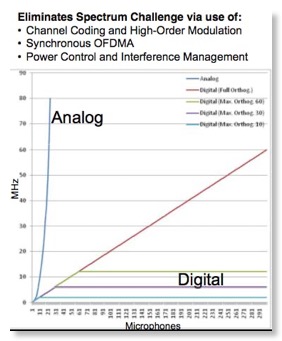
The plot at left from Qualcomm’s briefing shows that with today’s analog wireless microphone technology, wideband FM dating back to Maj. Armstrong in the 1930s, capacity increases slowly with available spectrum. While this technology uses bandwidths of 100 kHz or more, the real limit in places requiring a high density of wireless mics - such as a theater stage - is intermodulation which generally results from receivers or antenna amplifiers that are not sufficiently linear.
Intermod in theaters can also result from wireless mic transmitters that are near each other (such as redundant mics on key players and actors who are standing next to or embracing each other) and interact with each other due to the lack of adequate RF isolation in their designs. While intermod could be corrected by improving analog FM equipment, today’s digital technology offers options that are intrinsically immune to intermod. The new Qualcomm chipset uses the same basic OFDMA technology used in WiMAX and LTE.
With the kind permission of PolicyTracker, here is their recent news report:
(Note that in UK-speak PMSE = program(me) making and special events = wireless mics)
Qualcomm announces chipset for digital wireless mic
©PolicyTracker Oct 27, 2010
by Martin Sims
Qualcomm says it has developed a chipset for an advanced digital wireless microphone with much greater spectrum efficiency than current analogue models. However, industry experts are sceptical about its likely power consumption.
While digital switchover will bring digital TV to everyone and more spectrum for mobile operators, wireless microphone users and the PMSE (programme-making and special events) community could lose out. In recent years, 790-862 MHz has been an “unofficial harmonised band”, according to Wolfgang Biltz of the Association of Professional Wireless Production Technology. “Travel all over Europe and you could always find a frequency which works for you – legally,” he said. However, 790-862 MHz will soon become the European mobile sub-band, meaning that many PMSE users will be looking for a new home.
The European Commission thinks that solving the problem requires action at the EU level and its recent digital dividend Communication called for the identification of harmonised bands. To help find these bands and to discuss other possible solutions, like the use of cognitive radio for PMSE and the transition to digital technologies for wireless microphones, the Commission held a worksop in Brussels on Tuesday 26 October.
Digital era closer than expected?
A move to digital could be one solution for wireless mics because increased spectral efficiency would mean that users could be accommodated in a smaller number of bands. So far the industry view has been that analogue mics will continue to dominate for many years to come. “We will see analogue transmissions for the next 10-15 years: it's efficient and higher quality and that is key to us,” Volker Schmitt of Sennheiser told the workshop.
This ought not to influence policy until it is embedded in a mic and being sold in a box
What surprised participants was Qualcomm's revelation that it had developed a chipset for a digital wireless microphone. Cyril Measson, a senior engineer at the company, said they were keen to partner with manufacturers and could make the chipset available to them in six months. “We are not talking about the future, we are talking about now,” he said.
Qualcomm's technology, which is intended for the professional wireless microphone market, is based on synchronous OFDMA and operates within existing 200 Khz channels. It uses the 2.4 GHz band and offers a range of up to one kilometre. Sound quality is 24 bit / 48 khz and it can pack 30 mics into 6 MHz.
Significantly, Measson said Qualcomm’s digital system could achieve the same latency as analogue systems: a delay of only three milliseconds at 100-200 metres. Latency, or the time it takes for the sound to be electronically processed and amplified, is crucial for PMSE users like musicians as playing or singling along is impossible if there is a significant delay in hearing the sound coming back.
Measson also said that the digital technology would enable the performer to transmit data back, allowing new ways of using wireless microphones. Qualcomm calls this its Interactive Venue Media System.
The power problem
Volker Schmitt of Sennheiser accepted that digital was the future and called Qualcomm's system “pretty amazing” but said there were great concerns about battery usage. “We have had a look at digital, we have looked at OFDM but it is not here yet because of power consumption,” he said. Schmitt said the problem came because of the need to use a special type of signal amplifier in order to achieve high audio quality with low latency. These linear RF amplifiers have very high power consumption, meaning that battery life would be too short and the battery packs would be too large for performers to wear. However, Measson said Qualcomm’s was a state of the art technology with an advanced power control system.
Digital mics may arrive more quickly than many people think
Like Schmitt, many attendees remained concerned about the battery life issue. “This is vapour-ware,” said one participant. “It ought not to influence policy until it is embedded in a mic and being sold in a box.”
Schmitt's view of the digital timescale was very different to Measson's. “Digital will come, but it's not around the corner,” he said. “We need three to five years for research, followed by extensive field tests...then two to three years for product development.”
Professor Georg Fischer, co-chairman of the ETSI group on cognitive PMSE systems, told participants that a move to digital alone would not resolve the issues facing the industry. He told the seminar that PMSE was not spectrally inefficient per se, considering the audio quality required, and he saw great possibilities in using the cognitive approach to analogue wireless mics.
It is also worth noting that manufacturers' pessimism about the development of digital wireless mics is not universally shared. “Digital mics are available, I have heard them in performances and they were perfectly acceptable,” one workshop participant said. “They may arrive more quickly than many people think.”
Note the key parameters in the above: 24 bit digitization (CD quality sound), 48 kHz sampling (resulting in 20+ kHz of audio, again CD quality), and < 5 ms latency/delay (important in live theater). There is some question about power consumption/battery life but it is hard to see that that is a key issue as actors do not stay on stage for hours at a time. I was amused by the quote: “ ‘This is vapour-ware,’ said one participant. ‘It ought not to influence policy until it is embedded in a mic and being sold in a box.’ “ How many times have I heard this thought? Regulators should wait under R&D people use private capital to develop products that have no market without regulatory action and not make any decisions until the technology is fully proven. Where would computer technology be if the Federal Computer Commission has to actively approve every new PC model’s technology under ill defined criteria in front of a crowd of competitors before it could be sold?
Compare the efficiency given by Qualcomm, “30 mics in 6 MHz” with the statement in the FCC’s newly adopted 15.713(h)(9) “As a benchmark, at least 6 – 8 wireless microphones should be operating in each channel used at such venues (both licensed and unlicensed wireless microphones used at the event may be counted to comply with this benchmark).” The Qualcomm technology could achieve 4-5 times what FCC recently viewed as a benchmark.
This new Qualcomm announcement may obsolete the recent decision before it is even published in the Federal Register!
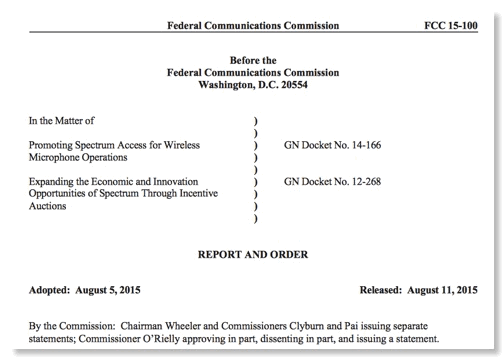
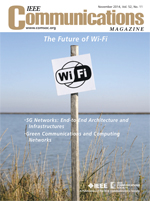




![Validate my RSS feed [Valid RSS]](valid-rss-rogers.png)

